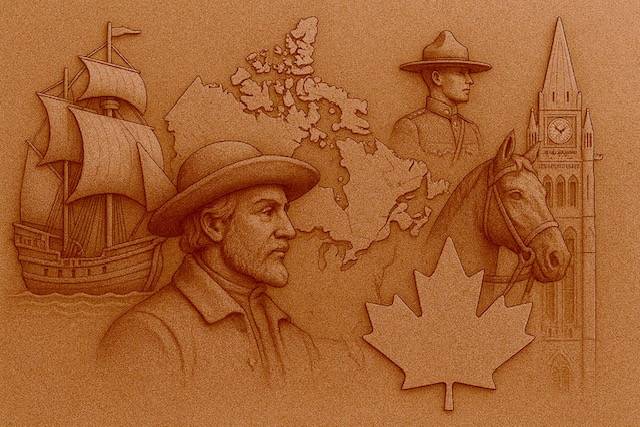History of Canada

Canada, the second largest country in the world in area (after Russia), occupies roughly the northern two-fifths of the continent of North America. Despite its great size, Canada is one of the world’s most sparsely populated countries. This low population density, combined with the grandeur of its landscape, has long shaped Canadian national identity. Dublin-born writer Anna Brownell Jameson, who explored central Ontario in 1837, described the wilderness as a seemingly interminable line of trees, boundless and mysterious.
Although Canadians are relatively few in number, they have built what many regard as a model multicultural society, welcoming immigrants from all continents. Canada also harbors vast natural resources and intellectual capital, rivalling few other countries. The head of government is the Prime Minister, and the capital is Ottawa. As of 2021, the estimated population is 38,148,000. The head of state remains the Queen of Canada (the British monarch), represented by the Governor-General.
Canada is officially bilingual in English and French, a reflection of its colonial history as a land contested by two European powers. The name "Canada" originates from the Huron-Iroquois word kanata, meaning village or settlement. French explorer Jacques Cartier adopted the name in the 16th century, and it gradually became synonymous with New France. After the British conquest, the name was later restored in 1791 and formalized in 1867 with the British North America Act, which created the Dominion of Canada. Full legislative independence was achieved in 1982 when Canada gained the right to amend its constitution.
Canada shares an 8,890-km (5,525-mile) border with the United States, the world’s longest undefended border. Most Canadians live within 300 km (185 miles) of this boundary. While Canada and the U.S. share cultural similarities, they differ in key ways. Canadians tend to favor centralized governance and community values over individualism. Internationally, they are more likely to play the role of peacemakers. Quebec, where more than three-fourths of the population speaks French, differs in religion, architecture, and schooling from English-speaking Canada. The country’s identity is also shaped by First Nations and Inuit cultures, and its population has grown increasingly diverse with immigration from Europe, Southeast Asia, and Latin America.
Canada plays an influential role globally. It is a key member of the Commonwealth and La Francophonie and was a founding member of the United Nations. Canada joined the Organization of American States in 1989 and signed the North American Free Trade Agreement (NAFTA) in 1992. It is also a member of the Organisation for Economic Co-operation and Development (OECD) and the Group of Seven (G7). The national capital, Ottawa, ranks behind Toronto, Montreal, and Vancouver in size but holds political prominence. Other major cities include Calgary, Edmonton, Quebec City, and Winnipeg.
Geographically, Canada spans six time zones and stretches from the Atlantic to the Pacific and northward into the Arctic Ocean. The land includes thousands of islands such as Newfoundland and those in the Arctic Archipelago. Despite being viewed as a northern country, southern Ontario extends as far south as northern California. Canada's vastness contributes to a strong sense of regionalism. Terms such as Atlantic Provinces, Central Canada, Prairie Provinces, and the North are commonly used to describe different regions.
Canada's landforms include a vast central basin rimmed by mountain ranges—the Cordillera in the west, Appalachians in the east, and Innuitian Mountains in the north. The Canadian Shield dominates, with some of the world’s oldest rocks and countless lakes formed by glaciation. The interior plains feature large sedimentary rock basins and fertile lands, especially in the Prairie Provinces, which are rich in natural resources like coal and oil. The Great Lakes–St. Lawrence lowlands are densely populated and agriculturally productive.
The Appalachian region, extending through Quebec and the Maritimes, features rounded mountains and dissected plateaus. The Western Cordillera along the Pacific coast contains young, towering mountain ranges like the Rockies and Coast Mountains. This region is rich in minerals and features dramatic fjords and Canada's tallest peak, Mount Logan. The Arctic Archipelago consists of shield extensions, lowlands, and the mountainous Innuitian Region.
Canada contains vast freshwater resources, including the Great Lakes and the Mackenzie River, its longest river. Most rivers flow northward into the Arctic or Hudson Bay, with hydroelectric development common where rapids and waterfalls occur. The climate ranges widely due to Canada’s size. Coastal areas are moderated by ocean currents, while the interior experiences extreme temperature variations. Precipitation is highest in British Columbia and lowest in the Arctic.
Snowfall patterns differ from rainfall, with heavier snow in interior and mountainous areas. Soils and vegetation vary widely. The tundra in the north features sparse, hardy vegetation and wildlife like caribou and polar bears. Boreal forests dominate central Canada, while grasslands occupy the drier southern interior plains. Deciduous and mixed forests appear in southern Ontario and Quebec. The Western Cordillera supports diverse forests influenced by elevation and rainfall.
Wildlife corresponds closely to vegetation zones. Species like moose, beavers, and lynx are found in boreal forests, while mountain goats and deer inhabit the Cordillera. Grasslands support smaller populations due to agricultural transformation. Canada’s ecosystems are rich but sensitive to climate and human activity.
Source: Britannica